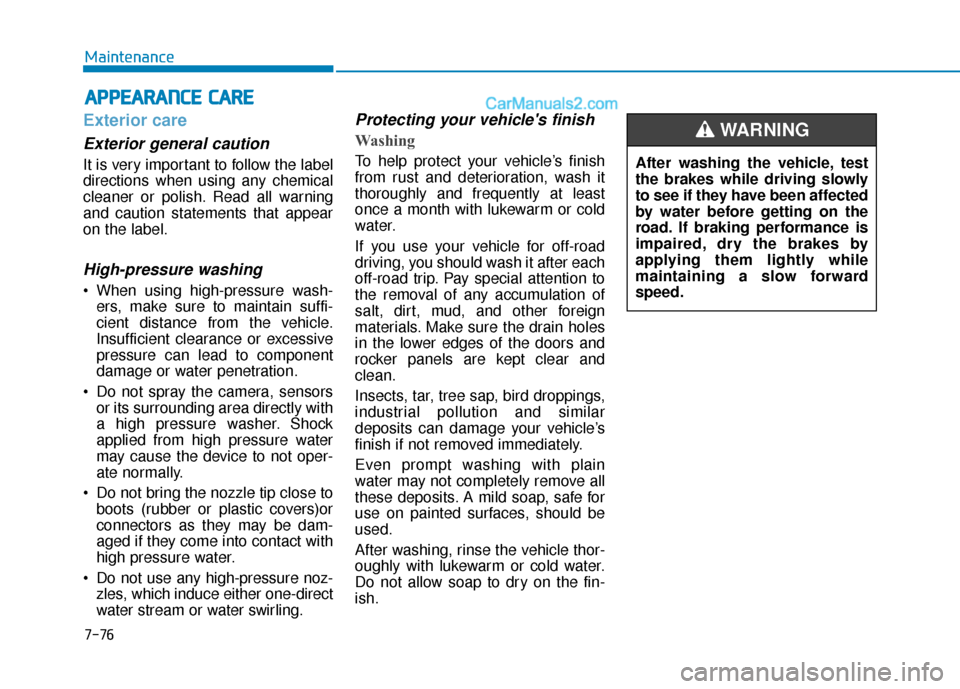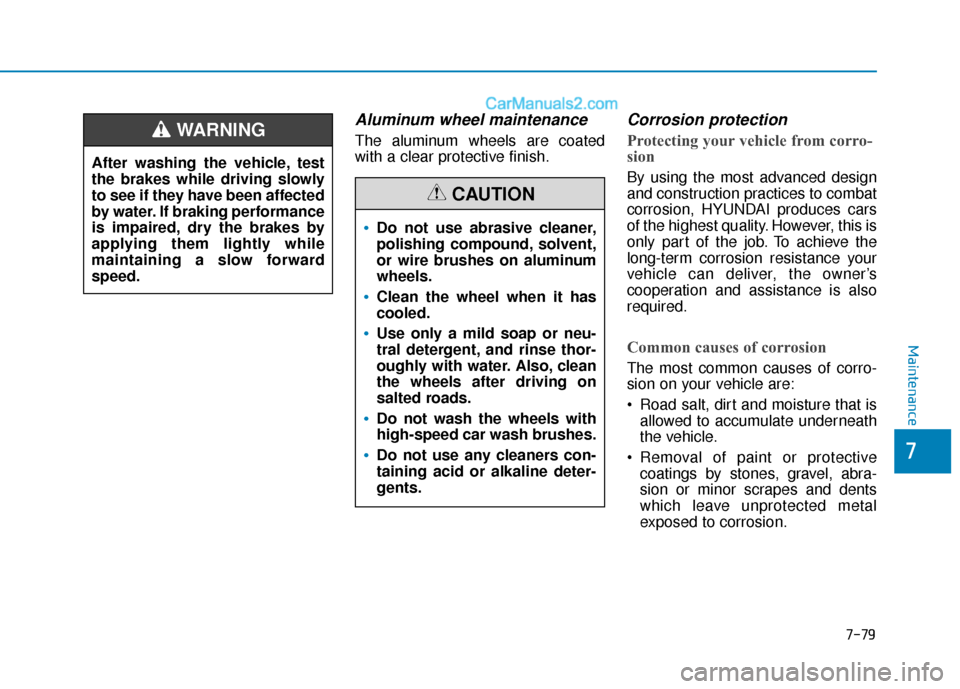2018 Hyundai Sonata Plug-in Hybrid warning light
[x] Cancel search: warning lightPage 445 of 552

7-50
Maintenance
F
FU
U S
SE
E S
S
A vehicle’s electrical system is pro-
tected from electrical overload dam-
age by fuses.
This vehicle has 2 (or 3) fuse panels,
one located in the driver’s side panel
bolster, the other in the engine com-
partment near the battery.
If any of your vehicle’s lights, acces-
sories, or controls do not work, check
the appropriate circuit fuse. If a fuse
has blown, the element inside the
fuse will be melted or broken.
If the electrical system does not
work, first check the driver’s side
fuse panel. Before replacing a blown
fuse, turn the engine and all switches
off, and then disconnect the negative
battery cable. Always replace a
blown fuse with one of the same rat-
ing.
If the replacement fuse blows, this
indicates an electrical problem. Avoid
using the system involved and imme-
diately consult an authorized
HYUNDAI dealer.Information
Three kinds of fuses are used: blade
type for lower amperage rating, car-
tridge type, and fusible link for higher
amperage ratings.
i
Normal
■
Blade type
■ Cartridge type Blown
Normal Blown
Normal Blown
OLF074075
Do not use a screwdriver or any
other metal object to remove
fuses because it may cause a
short circuit and damage the
system.
CAUTION
NEVER replace a fuse with any-
thing but another fuse of the
same rating.
A higher capacity fuse could
cause damage and possibly
cause a fire.
Do not install a wire or alu-
minum foil instead of the
proper fuse - even as a tem-
porary repair. It may cause
extensive wiring damage and
possibly a fire.
WARNING
Normal Blown
■ Multi fuse
Page 462 of 552

7-67
7
Maintenance
L
LI
IG
G H
H T
T
B
B U
U L
LB
B S
S
Consult an authorized HYUNDAI
dealer to replace most vehicle light
bulbs. It is difficult to replace vehicle
light bulbs because other parts of the
vehicle must be removed before you
can get to the bulb. This is especially
true for removing the headlamp
assembly to get to the bulb(s).
Removing/installing the headlamp
assembly can result in damage to
the vehicle.Information
After heavy driving, rain or washing,
headlamp and trunk lenses could
appear frosty. This condition is caused
by the temperature difference
between the lamp inside and the out-
side temperature. This is similar to the
condensation on your windows inside
your vehicle during the rain and does-
n’t indicate a problem with your vehi-
cle. If the water leaks into the lamp
bulb circuitry, have your vehicle
checked by an authorized HYUNDAI
dealer.
i
Prior to replacing a lamp,
depress the foot brake, move
the shift lever into P (Park)
apply the parking brake, place
the igntion switch to the
LOCK/OFF position, and take
the key with you when leaving
the vehicle to avoid sudden
movement of the vehicle and
to prevent possible electric
shock.
Be aware the bulbs may be hot
and may burn your fingers.
WARNING
Page 463 of 552

7-68
Maintenance
Headlamp, parking lamp,
turn signal lamp and side
marker light bulb replacement(1) Headlamp (Low)
(2) Headlamp (High)
(3) Turn signal lamp
(4) Side marker lamp
(5) Daytime running lamp (DRL) /Parking lamp
Headlamp (Halogen bulb)
OLMB073042L
Handle halogen bulbs with
care. Halogen bulbs contain
pressurized gas that will pro-
duce flying pieces of glass
that could cause injuries if
broken.
Wear eye protection when
changing a bulb. Allow the
bulb to cool down before han-
dling it.
WARNING
OLFH077050
OLFH077051
■Type A
■Type B
Page 471 of 552

7-76
Maintenance
A
AP
PP
PE
EA
A R
RA
A N
N C
CE
E
C
C A
A R
RE
E
Exterior care
Exterior general caution
It is very important to follow the label
directions when using any chemical
cleaner or polish. Read all warning
and caution statements that appear
on the label.
High-pressure washing
When using high-pressure wash-
ers, make sure to maintain suffi-
cient distance from the vehicle.
Insufficient clearance or excessive
pressure can lead to component
damage or water penetration.
Do not spray the camera, sensors or its surrounding area directly with
a high pressure washer. Shock
applied from high pressure water
may cause the device to not oper-
ate normally.
Do not bring the nozzle tip close to boots (rubber or plastic covers)or
connectors as they may be dam-
aged if they come into contact with
high pressure water.
Do not use any high-pressure noz- zles, which induce either one-direct
water stream or water swirling.
Protecting your vehicle's finish
Washing
To help protect your vehicle’s finish
from rust and deterioration, wash it
thoroughly and frequently at least
once a month with lukewarm or cold
water.
If you use your vehicle for off-road
driving, you should wash it after each
off-road trip. Pay special attention to
the removal of any accumulation of
salt, dirt, mud, and other foreign
materials. Make sure the drain holes
in the lower edges of the doors and
rocker panels are kept clear and
clean.
Insects, tar, tree sap, bird droppings,
industrial pollution and similar
deposits can damage your vehicle’s
finish if not removed immediately.
Even prompt washing with plain
water may not completely remove all
these deposits. A mild soap, safe for
use on painted surfaces, should be
used.
After washing, rinse the vehicle thor-
oughly with lukewarm or cold water.
Do not allow soap to dry on the fin-
ish. After washing the vehicle, test
the brakes while driving slowly
to see if they have been affected
by water before getting on the
road. If braking performance is
impaired, dry the brakes by
applying them lightly while
maintaining a slow forward
speed.
WARNING
Page 474 of 552

7-79
7
Maintenance
Aluminum wheel maintenance
The aluminum wheels are coated
with a clear protective finish.
Corrosion protection
Protecting your vehicle from corro-
sion
By using the most advanced design
and construction practices to combat
corrosion, HYUNDAI produces cars
of the highest quality. However, this is
only part of the job. To achieve the
long-term corrosion resistance your
vehicle can deliver, the owner’s
cooperation and assistance is also
required.
Common causes of corrosion
The most common causes of corro-
sion on your vehicle are:
Road salt, dirt and moisture that isallowed to accumulate underneath
the vehicle.
coatings by stones, gravel, abra-
sion or minor scrapes and dents
which leave unprotected metal
exposed to corrosion.
After washing the vehicle, test
the brakes while driving slowly
to see if they have been affected
by water. If braking performance
is impaired, dry the brakes by
applying them lightly while
maintaining a slow forward
speed.
WARNING
Do not use abrasive cleaner,
polishing compound, solvent,
or wire brushes on aluminum
wheels.
Clean the wheel when it has
cooled.
Use only a mild soap or neu-
tral detergent, and rinse thor-
oughly with water. Also, clean
the wheels after driving on
salted roads.
Do not wash the wheels with
high-speed car wash brushes.
Do not use any cleaners con-
taining acid or alkaline deter-
gents.
CAUTION
Page 498 of 552

I-4
Driver assist system ......................................................3-119Rear parking assist system .......................................3-120
Rear parking assist system precautions....................3-123
Rear view camera .....................................................3-119
Driver attention alert system (DAA) ..............................5-63 Resetting the system ...................................................5-65
System malfunction ....................................................5-65
System setting and activation .....................................5-63
System standby...........................................................5-65
Driver position memory system .....................................3-14 Easy Access Function .................................................3-15
Storing Positions into Memory ..................................3-14
Driving the Hybrid/Plug-in Hybrid Vehicle ....................H22 Changing plug-in hybrid mode ...................................H26
Energy flow.................................................................H38
Hybrid system gauge ..................................................H24
Special features ...........................................................H23
Starting the vehicle .....................................................H22
Warning and indicator lights.......................................H27
Warning messages.......................................................H28 Emission control system .................................................7-84
Crankcase emission control system ...........................7-84
Evaporative emission control system including onboard refueling vapor recovery (ORVR) ............7-84
Exhaust emission control system ...............................7-85
Engine ........................................................................\
.......8-2
Engine compartment..................................................1-6, 7-3
Engine coolant/inverter coolant ......................................7-19 Changing engine coolant ............................................7-22
Checking the engine/inverter coolant level................7-19
Engine number ..................................................................8-9
Engine oil ........................................................................\
7-17 Checking the engine oil and filter ..............................7-18
Checking the engine oil level .....................................7-17
Engine Start/Stop button ...................................................5-5 Engine Stop/Start button positions ...............................5-7
Illuminated Engine Start/Stop button ...........................5-6
Starting the hybrid system............................................5-9
Explanation of scheduled maintenance items.................7-14
Exterior features..............................................................3-46 Fuel Filler Door (Hybrid) ...........................................3-53
Fuel Filler Door (Plug-in hybrid) ...............................3-56
Hood ........................................................................\
...3-46
Smart Trunk ................................................................3-50
Trunk ........................................................................\
..3-47
Index
E
Page 499 of 552

I-5
Exterior overview (I) ........................................................1-2
Exterior overview (II) .......................................................1-3
Fuses ........................................................................\
.......7-50Engine compartment panel fuse replacement ............7-52
Fuse/relay panel description .......................................7-54
Instrument panel fuse replacement.............................7-51
Hazard warning flasher .....................................................6-2
HEV (Hybrid electric vehicle) system ..............................H2 Hybrid Vehicle ..............................................................H2
Hybrid starter & generator (HSG) belt ...........................7-22 Checking the hybrid starter & generator (HSG) belt .7-22 If an accident occurs .......................................................6-34
If the engine overheats ......................................................6-7
If the vehicle will not start ................................................6-3
If the engine turns over normally but doesn't start ......6-3
If you have a flat tire ......................................................6-15 With tire mobility kit - Type A...................................6-15
With tire mobility kit - Type B...................................6-22
Important Safety Precautions............................................2-2 Air Bag Hazards ...........................................................2-2
Always Wear Your Seat Belt ........................................2-2
Control Your Speed ......................................................2-3
Driver Distraction.........................................................2-2
Keep Your Vehicle in Safe Condition ..........................2-3
Restrain All Children....................................................2-2
In case of an emergency while driving .............................6-2 If the vehicle stalls at a crossroad or crossing .............6-2
If the vehicle stalls while driving .................................6-2
If you have a flat tire while driving .............................6-3
Instrument cluster ...........................................................3-60 Gauges ........................................................................\
3-63
Instrument cluster control ..........................................3-62
Warning and indicator lights ......................................3-67
Warning messages ......................................................3-81
Instrument panel overview ...............................................1-5
I
Index
F
H
I
Page 501 of 552

I-7
Multimedia system............................................................4-2Antenna ........................................................................\
4-2
Audio (Display Audio) / Video / Navigation System (AVN) ........................................4-4
AUX, USB and iPod
®Port ..........................................4-2
Bluetooth®Wireless Technology Hands-Free ..............4-4
Features of your vehicle ...............................................4-7
How vehicle audio works .............................................4-5
Steering Wheel Audio Control .....................................4-3
Owner maintenance ..........................................................7-5 Owner maintenance schedule .......................................7-6
Panorama sunroof ...........................................................3-42 Closing the sunroof ....................................................3-44
Resetting the sunroof..................................................3-45
Sliding the sunroof .....................................................3-43
Sunshade.....................................................................3-4\
3
Tilting the sunroof ......................................................3-44
Parking brake ..................................................................7-24 Checking the parking brake .......................................7-24
PHEV (Plug-in electric vehicle) system ...........................H3 Plug-in Hybrid Vehicle .................................................H3 Recommended lubricants and capacities ..........................8-6
Recommended SAE viscosity number .........................8-7
Refrigerant label ...............................................................8-9
Reporting safety defects..................................................8-11
Safety precautions for hybrid system ..............................H42 High Voltage Battery Air Intake .................................H46
High Voltage Battery System......................................H42
If an accident occurs ...................................................H48
Safety Plug ..................................................................H46
When the hybrid vehicle shuts off ..............................H49
Scheduled maintenance services.......................................7-8 Maintenance under severe usage conditions ..............7-12
Normal maintenance schedule .....................................7-9
Severe driving conditions ...........................................7-13
Seat Belts ........................................................................\
2-24 Additional Seat Belt Safety Precautions ....................2-32
Care of Seat Belts .......................................................2-35
Seat Belt Restraint System .........................................2-26
Seat Belt Safety Precautions ......................................2-24
Seat Belt Warning Light .............................................2-25
I
Index
O
R
S
P